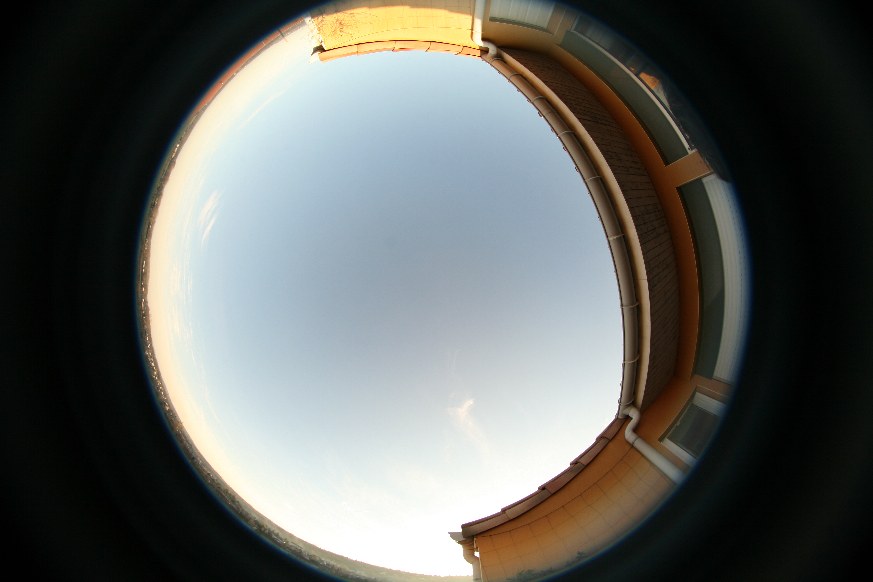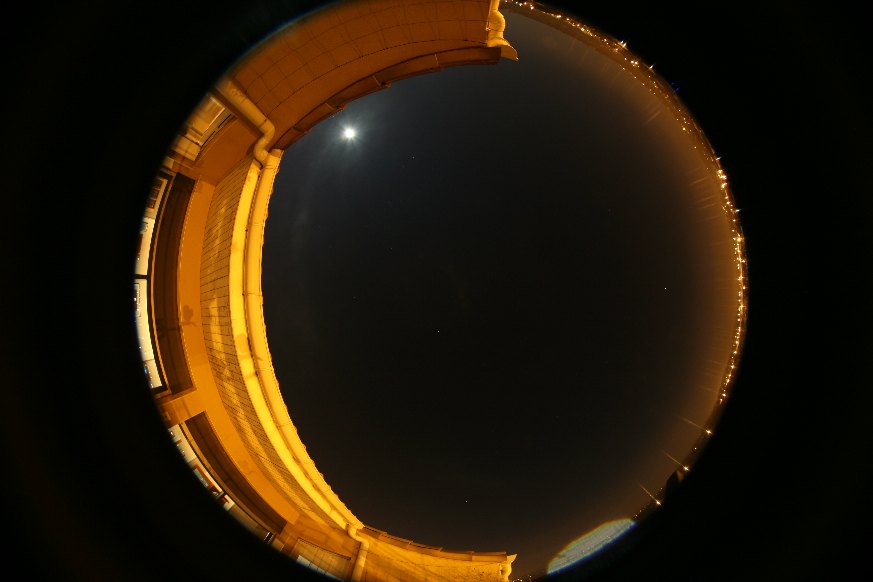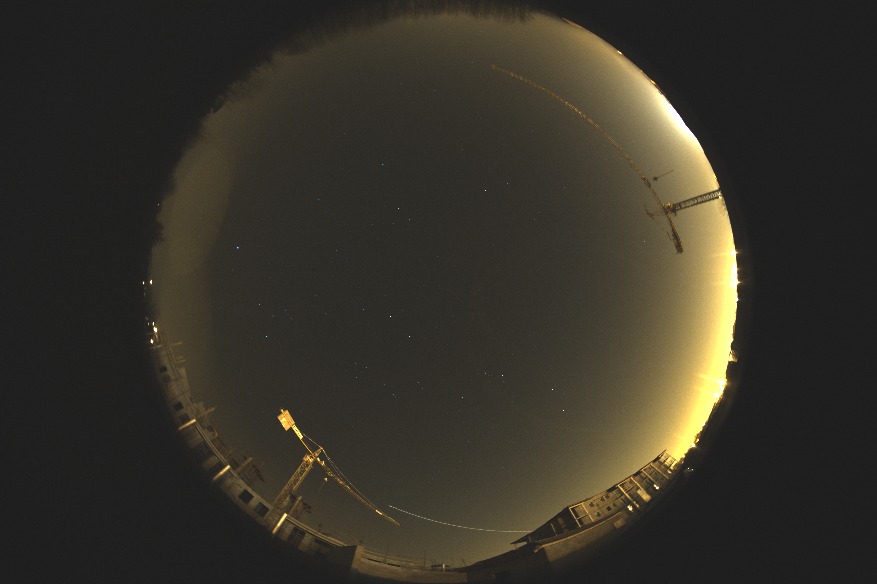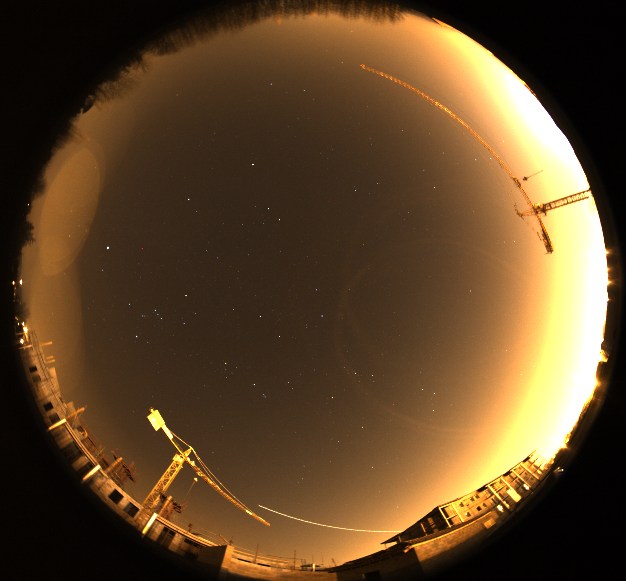
8 mm Peleng fisheye and
Canon EOS 5D DSLR

This page is a brief note about the Russian 8-mm focal length f/3.5 Peleng
fisheye. For a complete review of the lens read the excellent paper by Cyril
Cavadore here. All the essential comments about the Peleng 8-mm are
given by C. Cavadore. The present page add only an information about the use
of these lens with a Canon EOS 5D.
Compare the two following images, one taken with an EOS 350D, and one taken with an EOS 5D:

Peleng 8 mm fisheye
@f/8 on a Canon EOS 350D (sensor nearly identical to the 20D).

Peleng 8 mm fisheye
@ f/8 on a Canon EOS 5D.
The 350D image is more detailed because the smallest size of the pixels (6.42 Ám for the 350D/20D, 8.2Ám for the 5D), but the 5D full frame sensor is a real advantage with this type of lens. However, one can note that even a 24x36 mm detector, the circular field misses slightly along the small direction of the image. But the loss remains very weak with the 5D ; the 180░ field is nearly complete.
I confirm the Cavadore's comment about the image quality: the sharpness is good for the price (but the use at f:8 relative aperture is recommended for an ultimate point image). Note also the limited sun flare. The ratio performance/cost is very favorable!

Another
ESOS 5D view from my "observatory"...

...
and a panoramic projection of the same image (Iris software, click
here for details about fisheye projections and more about the topic).

A
crop of the very far field of the fisheye for appreciate the resolution and
diffusion of this part of the image (taken @ f/8). The test is severe.
Some lateral color, but the chromatic aberration is well controlled.

A
night version of the same point of view.

The
panoramic projection.

Now
the lens is directed toward the horizon. Canon EOS 5D + Peleng 8 mm @ f/8. Exposure
15 s @ ISO 500.

A
view of the "Castanet" observatory, where the images are taken.

The
Peleng lens is an ideal compagnon for evaluate the sky quality! The Toulouse
city is in the north. 30 sec. exposure @ 400 ISO - Canon 5D.
 A
360░ panorama extracted from the latest image.
A
360░ panorama extracted from the latest image.
STAR TEST

Stack
of 5 x 30 s. unguided exposure. Canon 5D + Peleng 8-mm @ f/8
|
|
|

The
registered version of the 5x 30 seconds sequence. Peleng 8 mm @ f/8. EOS 5D
@ ISO 400.
|
|
|

Single
guided shot of 240 seconds. Peleng 8 mm @ f/8. Crop 75%. Geminii/Orion region.

The
setup used for take the guided image: A TG-SP Takahashi equatorial mount.
IMAGE PROCESSING
DEMONSTRATION
Some
celestial equatorial projections
See
also the MAP documentation
(version
en franšais ici)

The
starting zenithal view - Single shot 30 seconds Peleng image. Canon 5D @ ISO
400.
First the Peleng image is projected onto a sphere (Fisheye... tool of Geometry menu):

Parameters
of the spherical projection for a 5D equiped with the Peleng 8 mm.
Then, the spherical image is rotated by 90░ relative
to its center (X=2193, Y=1460, i.e. the middle of the image) (command line
>rot 2193 1460 90, or use Rotation... dialog box of Geometry
menu). The meridian is now vertical: a facility for angles definition. The
image is named SPHERE_PROJEC (it is an example):

The
spherical projection. Equatorial system circles are drawed with an angular
step of 10░.
For draw the circles, define the parameters file SPHERE.LST:
0
0.0 46 0
4386 2920
2193
1460 1460
0 0
-180 180 -90 90
0 0
0 0.5
10 10 3
Then
>GRID SPHERE 0
The value for PHIP (46░) is equal to 90░- (latitude of the observatory).
Now the result of a "Postel" polar projection (crop of the pole only):

Postel
polar projection. Ursa Major, Ursa Minor and Cassiopea constellations.
The definition of the polar projection (POSTEL.LST):
7
0 0 0
0 0
0 0 0
0
0
-180 180 0 90
0 0
0 0.1
10 10 3
>LOAD
SPHERE_PROJEC
>MAP SPHERE POSTER
>GRID POSTEL 200
Now an ideal projection for display intermediate declinaison:

Albers
polar conic projection. The selected declinaison of the tangent point of the
cone is +45░ (L1=L2=45░). Gemini, Auriga and Taurus constellations.
The ALBERS.LST file:
12
0.0 0 0
0 0
0 0
0
0 0
-180 180 -10 90
45 45
0 .1
10 10 3
>LOAD SPHERE_PROJEC
>MAP SPHERE ALBERS
>GRID
ALBERS 240
And now, the equarorial contries:

Part
of a Lambert cylindrar projection. Canis Major, Orion Gemini, and Taurus constellations.
Definition of the Lambert projection (file LAMBERT.LST):
1
0.0 0 0
0 0
0 0
0
0 0
-180 180 -75 75
0 0
0 .07
10 10 3
>LOAD SPHERE_PROJEC
>MAP SPHERE LAMBERT
>GRID
LAMBERT 240
Here a detail of the Lambert projection, well adapted for examine equatorial zones.

Remember that all the images of the demonstration are derived from an unique single shot images!